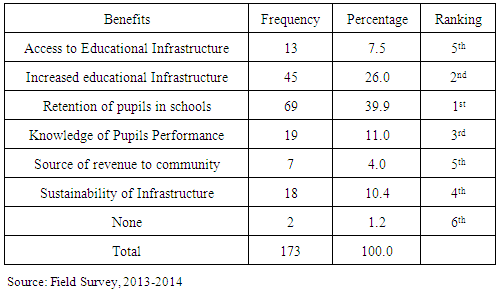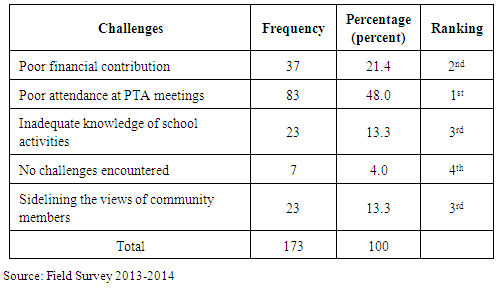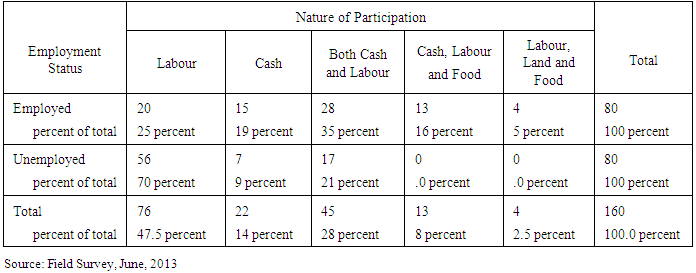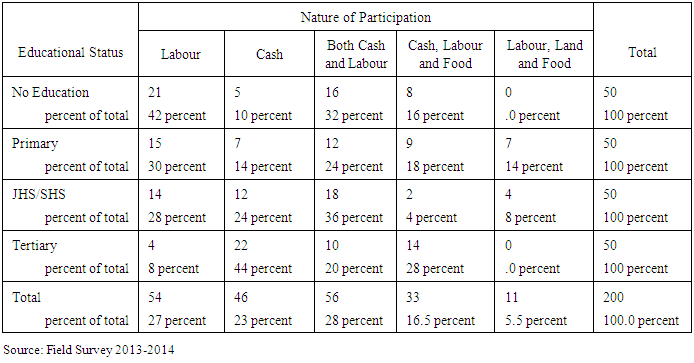-
Paper Information
- Paper Submission
-
Journal Information
- About This Journal
- Editorial Board
- Current Issue
- Archive
- Author Guidelines
- Contact Us
Education
p-ISSN: 2162-9463 e-ISSN: 2162-8467
2015; 5(5): 129-141
doi:10.5923/j.edu.20150505.02

Community Participation in Educational Infrastructure Development and Management in Ghana
Emmanuel Wedam 1, Joseph Yaw Dwamena Quansah 2, Irene Akobour Debrah 2
1Department of Development Studies, University for Development Studies, Wa, Ghana
2Faculty of Education, University for Development Studies, Wa, Ghana
Correspondence to: Emmanuel Wedam , Department of Development Studies, University for Development Studies, Wa, Ghana.
| Email: |  |
Copyright © 2015 Scientific & Academic Publishing. All Rights Reserved.
This work is licensed under the Creative Commons Attribution International License (CC BY).
http://creativecommons.org/licenses/by/4.0/

Over the years, governments have sought for alternative ways of providing the needs of communities since resources from central governments cannot meet the needs of all. As such, several approaches have been tried over time. Government first adopted the supply approach but in its search for alternatives, community participation in the planning of infrastructure development was advocated for. Community participation approach in the planning of infrastructure helps to generate or mobilize enough resources from both central government and the community towards the implementation of projects. Moreover, community participation also helps to ensure sustainability of the projects implemented since communities play a management role. In this study, we were able to establish a direct linkage between community participation and increase in school enrolment, access and utilisation of educational infrastructure. While there were improvements in community interaction and educational infrastructure sustainability, the quality and nature of educational infrastructure provided by the communities were lamentable in most cases. In this study, we recommend that the major challenges that affect community participation and management must be gradually plunged through continuous education and sensitisation. Again, in order for community participation in educational infrastructure to be very effective, there must be a critical assessment of stakeholder power in the context of the nature and type of participation and management being rolled out.
Keywords: Community Participation, Educational Infrastructure, Management, Planning, Schools
Cite this paper: Emmanuel Wedam , Joseph Yaw Dwamena Quansah , Irene Akobour Debrah , Community Participation in Educational Infrastructure Development and Management in Ghana, Education, Vol. 5 No. 5, 2015, pp. 129-141. doi: 10.5923/j.edu.20150505.02.
Article Outline
1. Introduction
- Education is a catalyst to development and a critical area of attention. Apart from the obvious need to generate income, particularly in the era of economic reform and the pressure that national discipline imposes on various sectors of the population, it is an indicator of status, an avenue for advancement and empowerment as well as where and how priorities are indicated for actions [1]. In Africa, the major headache over the years has always been how to provide accessible, equitable and affordable education to all school going children in deference of their location, gender, social and economic status; a problem that has always been attributed to lack of resources and capacity [2].In the 1980’s, Ghana embarked on a public administration reform aimed at decentralilizing and restructuring the system of public and political administration as well as governance and development. This took the form of de-concentration, devolution and delegation of political power. The genesis of these reforms emerged after the Provisional National Defence Council (PNDC) a military government which took office in 1981 released its first major policy strategy known as “PNDC Policy Guidelines” in 1982 [3]. In this document, the PNDC government encapsulated two major policy stances on local government and decentralisation in Ghana. That is “the urgent need for participatory democracy to ensure that the bane of remote government that had afflicted Ghanaians since independence is done away with effectively, to render governments truly responsive and accountable to their constituencies. The assumptions of power by the people cannot be complete unless a truly decentralised government system is introduced to empower local government councils to initiate, coordinate, manage and execute policies in all matters affecting them within their localities” [Ibid].Over the past decades, many of the community development projects and programmes that were implemented in the past had a large gap between plan and implementation. Attempts to close this gap saw the introduction of the integrated rural development concept in most rural communities in Ghana. In principle, the concept sought to fill the gaps in the bottom-up planning approach which is a contrivance for local resource mobilisation. This is because it provokes a sense of resource ownership in local communities [4]. To this end, the World Bank stepped-up its efforts in enhancing and accelerating the participation of people in all sectors and aspects of its development projects. For instance, in the area of education, the Bank made far-reaching efforts to gain in-depth knowledge of how community participation could lead to an improvement in educational projects which was initiated in the 1980s. Now, a lot of research works have shown that there is a secured link between community involvement and the improvement of educational service deliveries. As a result, the World Bank has over the years been looking for new ways of interacting with local communities in the provision and delivery of educational projects and programmes [Ibid]. In Ghana, the establishment of the community secondary schools project is a classic example of the nation’s endeavour to accelerate community participation in the planning and management of educational infrastructure. Even though the government had long intended at accelerating the development of the nation’s human capital; improving access to education for all children is still a major headache [4, 2]. In order to reach its objective of educational accessibility, the country appealed to the Bank to provide assistance to about one hundred and forty (140) local communities in their quest to construct senior secondary schools in underprivileged and underserved rural communities [Ibid].Yet, despite the intention of government, there have been clear evidences that poor project management and lack of sustainability of projects were the result of lack of community involvement in the planning and management of such projects. As a result, current research in the area of community development encapsulates that the major questions of resource utilisation, ownership and sustainability are better understood in the context of community participation. Participation of community members in the planning and management of educational infrastructure has therefore taken the centre stage in most research studies across the world today. Even though it does not provide the universal-remedy to convalesce the quality of education, it is certainly a course that aids the achievements of quality education and the advancement of social equality and egalitarianism in communities. In Moree, a community on the coast of Ghana, a school built in the centre of the community was abandoned by the community mainly because the community members were not involved in the project [5]. This was the situation in many Ghanaian communities in the 1980’s and 1990’s because there were sever connections between schools and communities. Thus, local communities were not engaged in the provision and management of educational infrastructural projects [5]. According to Addae-Boahene, the Deputy Director of Community School Alliance Project, the situation in the 1980’s and 1990’s was that most local communities were of the perception that the schools built were for the government and therefore government had the sole right to improve on the level and quality of infrastructure as well as manage them [Ibid]. Again, lack of school infrastructure including teaching and learning materials in some local communities and poor academic performance has raised serious concerns about community participation in the planning and management of educational infrastructure. As a result, the researchers seek to explore how improved community participation has aided in educational infrastructure, project planning, implementation and management. In this paper, we presented the theoretical models and conceptual framework underlying the concept of community participation, planning and the management of educational infrastructure. This constitutes the second and third part of the study. In the fourth and five parts of this study, we discussed the methodology and the results of the study. The discussions of the results have been linked to the conceptual and theoretical models in order to provide a clear understanding of the issues discussed. In the final part, we presented the conclusion of the study, drawing mainly on the findings of the study.
2. Theoritical Framework
- In 1969, Sherry Arntein [1969 as cited in 6] developed the ladder of participation in an attempt to explain participation in three distinct phases. Even though these three stages may be mutually exclusive they are also progressively and directly linked to each other. At the time, Sherry’s ideas revolutionalise the process of how people viewed participation. According to Sherry, local communities can be found at each stage of the ladder or may progressively moved from the lower part of the ladder to the upper part of the ladder in successive modes at different times or at different phases of a project/programme. This include moving from giving information to consultation and then finally to the last stage which is referred to as community control. The figure (1) shown below depicts Sherry Arntein’s ladder of participation.
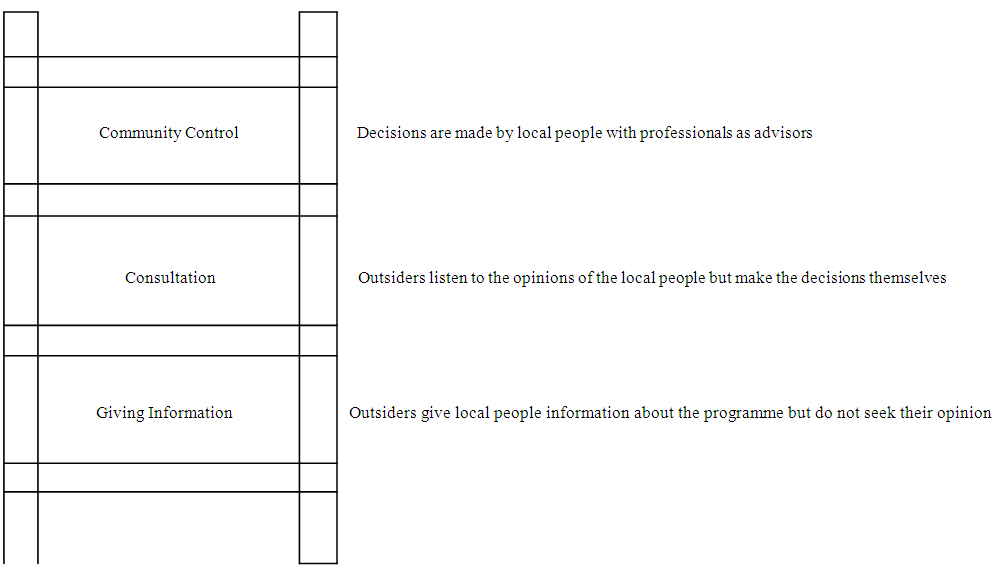 | Figure 1. Ladder of participation developed by Sherry Arnstein. Source: [6] |
 | Figure 2. A stakeholder power matrix for community participation. Source: (Hart et al, 1997) |
3. Conceptualising Community Participation
3.1. Community Participation
- Development lies in the minds of the people. The level of education of people determines their level of development. With their ability and capabilities, community members can manage their resources to ensure sustainable development. Development projects cannot be achieved when beneficiaries do not participate actively. The activities of the beneficiary communities bring about community participation. The success of every developmental project depends largely on community participation so that they can claim ownership of the said intervention [10]. In many African countries, responsibility for the provision of primary education has been legally either delegated or devolved to local governments, including the responsibility for school infrastructure. The rational for decentralisation is to improve basic service delivery because these services are consumed locally [11]. The experience in Ghana so far shows that community delegation has been the most effective in the provision and management of educational infrastructure. The notion that communities and local governments are unable to manage school construction is highly inaccurate. These experiences show that communities can organise themselves quickly to diagnose local problem, identify priorities, develop solutions and action plans, and execute those plans. Communities can be trained efficiently and successfully to carry out procurement and financial management methods that ensure transparency, economic and efficiency through adapted training methods. And these experiences show the quality of the work done by local contractors as in any other implementation arrangements. Heavily dependent on the efficiency of the technical supervision, which is always more efficient when the technical supervision service is competitively contracted out to private sector providers. This is true whether the contract is provided by communities or any other entity such as Ministry of Education, Local Government [12].
3.2. Community Participation and Educational Infrastructure Planning
- In many instances where the problem of inadequate access to basic education is constructed as a political and economic one, decentralisation is seen as the response in offering citizens increased opportunities to participate in local-decision making to improve access to education and makes it a worthwhile investment especially for the poor. It is therefore clear that imbalances and disparities in human and resource capacity in poor countries can actually make decentralisation exacerbate inequities in society and for that matter educational infrastructure planning [13]. Decentralisation is likely to provide the desired expansion of access and improvement in quality of provision. Community participation in principle is expected to shift decision making closer to local actors and stakeholders to improve access to services including education; the argument goes that this will create a more equitable society. The relational dynamics of the local level are highly significant to policy implementation and the achievement of Education for All (EFA) goals and the Millennium Development Goals (MDGs) concerning access [14]. In a research conducted by Adarkwah, [15] in the Hain community of the then Jirapa-Lambussie District Adarkwah established that there was a relationship between participation and school infrastructure provision. In his study, he assessed community participation in the provision of basic education on a sustainable base in the Hain community. The relevant aspect of this study was the examination of the community base willingness and capacity of the people with regards to community participation in the provision of basic education on a sustainable base in the Hain community. Attention was given to the gender participation in the basic educational affairs as well as institutional capacity of the community. The outcome of his study suggested that the people are poor but willing to participate effectively in the provision of adequate basic educational infrastructure on a sustainable base.Between 1976 and 1978 the Imo State Government in Nigeria spent N 14, 802, 000 on renovation and re-equipment of schools, whiles communities spent N12, 939, 000 on construction of 65 new ones. Over the period, 1976 to 1984, Igwe says the number of secondary schools increased from 147 to 476, and the capital cost of all the new ones were borne by their communities [16] Communities are encouraged to participate in the development of schools through all phases including planning, construction and operation. Their participation in construction can be through labour, provision of basic construction materials, or constructing the work to local artisans and small entrepreneurs. It has shown that the higher the level of community participation in the implementation of school infrastructure, the higher the probability of its completion within the planned period [4]. Educational needs are complex and diverse; meeting them requires multi sectorial strategies and actions which are integral to overall development efforts. Many partners must join with the education authorities, teachers and other educational personnel in developing basic education if it is to be seen as the responsibility of an entire society. This implies the active involvement of a wide range of partners-families, teachers, communities, private enterprises, government and Non-Governmental Organisations (NGOs), institutions to mention but a few in planning, managing and evaluation the many forms of basic education [17].
3.3. Community Participation and Educational Infrastructure Management
- Community participation has enormous contribution towards the management of educational infrastructure. In many countries in Africa for example, where system restructuring has been going on, it has come to be regarded as a key part of restructuring management of service delivery [18]. The new relationship that is emerging under decentralised governance between central and local government would seem to provide opportunities for how new roles and responsibilities might be conceptualised to provide equitable access to basic education and the management of the infrastructure in the communities within which they are found [13]. It has also been realised that reputable organisations allocate considerable amounts of resources towards community management of the projects provided. As such efficient use of financial and material resources promoted by organisations such as the World Bank and bi-lateral agencies, together with increased political advocacy for greater community ‘ownership’ and involvement in decision–making have led to efficient management of educational infrastructure [Ibid].One of the major factors to ensure sustainability of programmes is the availability of funds, whether from governments, private institution or donor organisation. In this regard, community participation in education cannot ensure the sustainability of school by itself since communities often times have to rely on external funding to keep the programme sustained. However, involving community is one of the ways to ensure that the benefits brought by development programmes will be maintained after the external interventions are stopped. Thus, sustainability is dependent on the degree of self-reliance developed in target communities and on the social and political commitment in the wider society to development programmes that support the continuation of newly self-reliance communities [19]. The quality of community provided educational infrastructure in the context of this study is defined in terms of the school infrastructure with all the complements including source of potable water, urinary and toilet for both male and female, adequate furniture and playground for a conducive environment for teaching and learning.
4. Methodology
4.1. Study Area
- The study area of this research work (Nadowli/Kaleo District) is found in the Upper West Region of Ghana. The district lies between latitude 11’ 20 north and longitude 3’ 10’ and 2’ 10’west. According to the 2010 population and housing census, the population of the district stands at 98,044 [20]. By the end of 2013, this figure is projected to have risen to 10, 2522. The economic orientation of the people in the district is mainly agriculture, which is done on subsistence basis [21]. Religious affiliation in the district is skewed in favour of Christianity.
4.2. Data Collection
- In this paper, for the purposes of time two communities were randomly sampled for the study using the lottery method. These communities were Serekpere and Kaleo. After the selection of the communities, we applied systematic random sampling to selected 173 households from Kaleo and Serekpere. This was because we realised that the units (households) under study were homogenous, that is each and every household in the communities selected (Serekpere and Kaleo) could provide the information required for the study [22, 23]. For the purposes of triangulation and in order to gain a deeper insight of the issue at hand [24, 25] the researchers collected supplementary data through Focus Group Discussions (FGDs), observation, and other relevant documents from secondary sources. The in-depth interviews were held with specific respondents who were connected with the study. These respondents included the District Chief Executive, the District Director of Education, Heads of selected schools, teachers, Assembly men in the selected communities and some opinion leaders. The idea for doing this was to enable the researchers meet the objectives of the study and to allow the respondents to actively participate and bring their understanding to enrich the study [26, 27]. In all, two separate FGD were held, one each in Serekpere and Kaleo. This technique is in most cases very appropriate if the researcher’s aim is to investigate the perceptions and views of people regarding a particular topic peculiar to their environment [28, 29]. The participants for the FGDs were purposively selected and were made up of both males and females. In all, ten (10) participants were engaged in the FGD in each case. To this end, the participants who were involved in the FGDs were meticulously selected in a manner that ensured that participants had adequate knowledge on the issues at hand. In order to ascertain the precision of the secondary data that was collected, the researchers decided to employ observation as part of the data collection process. According to Rafkin and Pridmore [6] this technique of data collection gives more direct information than other methods do. In this study, the researchers were able to observe the nature of infrastructure, the number of available infrastructure provided as per the actually number required, the provision of complementary facilities such as toilets, store rooms kitchens inter alia. The base line was that, these facilities contribute immensely to the quality of educational infrastructure. This method was applied in two distinct phases that is during data collection and the finial compilation of this research work.
5. Results and Discussions
5.1. Provision of Educational Infrastructure
- It is an undisputable fact that community participation increases access to educational infrastructure [13]. From the study, it was revealed that local communities have been initiating educational infrastructure for a very long time now. The main idea behind this initiative is primarily to provide school infrastructure where there is none or to increase the number of educational infrastructure so as to solve the problem of overcrowding in the limited number of schools already available. This confirms the study by Chapman [14], that the main essence of community participation is to shift decision making and its processes closer to local stakeholders in order to improve access to services including education. According to Chapman, the rationale behind this argument is that it will create equity in the access and utilisation of services in local communities. Schools like Kaleo Senior High Technical, Tindamba and Serepkere Nursery and Primary are typical examples of community initiated school infrastructure in the study district. The construction of these schools has drastically increased access not only in terms of educational acquisition but also in terms of distance. This is very significant if communities want to achieve Education for All and the targets set in the Millennium Development Goals (MDGs).In instances where schools have been provided by the government (Decentralised Local Government units also kwon as the District Assembly in the case of Ghana) or church groups, we realised that communities have provided supplementary infrastructure such as kitchens, toilets and urinary pits among others. The pie chart below (3) shows the various infrastructure provided by the communities studied.In Serekpere, apart from the new classrooms provided by the District Assembly, the kitchens and all other infrastructure were fully initiated and funded by the community with advisory support from the District Assembly. At this stage, community members exhibited Arm’s level power, [see figure, 2] which represents strategic level power. This is because their interventions were specifically targeted at providing certain amenities but beyond that they had no operational roles to play. The contribution of the community in the provision of the new classrooms and other resources were mainly in the form of communal labour.The study showed that local communities have been making significant contributions in the provision of educational infrastructure however, in many instances, lack of resources have considerably hindered the ability of these communities to continuously increase their support. Again, the quality and the nature of educational infrastructure provided by local communities were observed to be far below standard. In our visit to Serekpere, a primary school infrastructure provided by the community with local materials collapsed because the materials used for the construction were of poor quality. Our observations revealed visible cracks on the walls of the school and deep cracks in the floors of the classrooms. In the end, it took the intervention of the District Assembly to prevent the school from being shut down. This clearly exposes the gaps in community driven projects and programmes in rural communities. This finding supports the claims by Bray and Lillies [16], that in most cases the quality of the educational infrastructure provided by local communities is lamentable. According to Bray and Lillies [16] in several countries, community efforts have been strongly criticised for low quality educational infrastructure and for exacerbating regional and social imbalances.
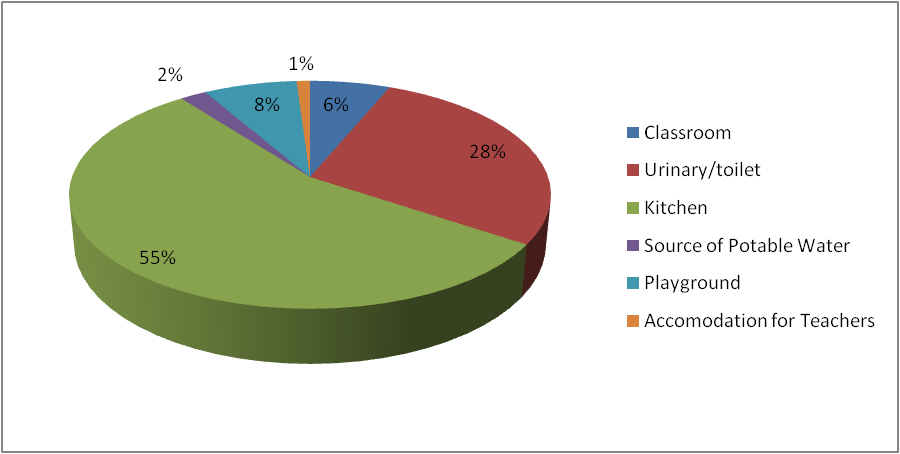 | Figure 3. Community Provided Educational Infrastructure. Source: Field Survey 2013-2014 |
5.2. Sources of Funds for Educational Infrastructure
- The District Assembly was the major provider of educational infrastructure in the district and as such, the greatest financial contribution in terms of funds for educational infrastructure in the district came from the district Assembly. (See figure 4 for the other sources of educational infrastructure funding).
 | Figure 4. Graph showing the main sources of funding for Educational Infrastructure. Source: Field Survey 2013-2014 |
5.3. Forms and Nature of Participation in Educational Infrastructure
- Over the years, community participation in the provision of educational infrastructure has been in various forms and nature. In this study, cash, labour, land and provision of food inter alia were the main areas where communities participated in the provision of educational infrastructure. In some cases, they were often consulted in the planning, implementation and management of educational infrastructure by the District Assembly, church groups, Non-Governmental Organisations (NGOs) among others. These groups in collaboration with the communities determined the location of school infrastructure in the community. Alternatively, in cases where the funding was provided by either the government (District Assembly) or church groups, local communities participated by providing land and labour to the project. For instance, out of 173 households interviewed, 43.0 percent participated in the provision of infrastructure in the form of labour, 11.0 percent participated by providing financial resources, 33.0 percent contributed in the form of both labour and financial resources, 9 percent participated by providing cash, labour and food. Again, 2.0 percent provided labour, land and food and an insignificant percentage of 2.0 did not participate in any form at all. These are illustrated in figure 5 below.
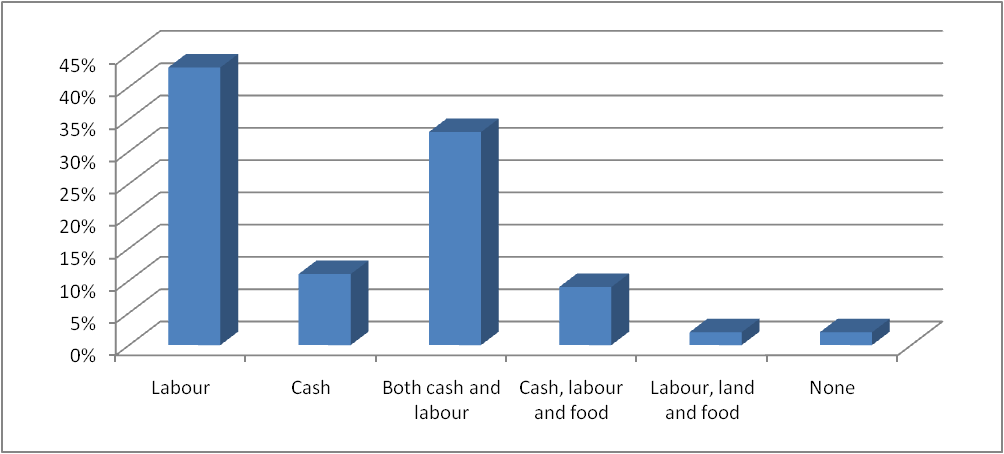 | Figure 5. Graph showing the forms of Community Participation in Educational Infrastructure. Source: Field Survey 2013-2014 |
5.4. Prospects of Community Participation in Educational Infrastructure
- It is very important to stress that community participation leads to the sustainability of development projects and programmes [30]. In Serekpere, community participation in the provision of educational infrastructure led to the construction of the first ever school in the community. In Kaleo, the construction of the Tindamba School by the community helped reduced the pressure on the few schools that existed at the time. Other associated benefits related to community participation in the provision of educational infrastructure in the study district were increase in retention and transition of pupils. The statement below captures it all;“through community participation, we have managed to provide for ourselves services that would have taken several petitions and a very long time to come by. Through our collective efforts, we have been able to build more classrooms to absorb the increasing numbers of children who wanted to access formal education but could not for lack of space. What I am even more proud of is how sometimes we are able to visit some of the schools to check on what is happening”. Monday-25/08/2014.Prosper Kaavaripour – An opinion leader in Kaleo.For some respondents, by participating, community members were able to help sustain the life span of educational infrastructure through planned maintenance. The table (1) below shows the proportion of respondents and the various reasons regarding the benefits of community participation in educational infrastructure.
|
5.5. Community Participation and Management of School Infrastructure Management
- The communities studied shared the view that community’s had a management role to play in sustaining educational infrastructure regardless of the provider. Local communities had played immense roles in the management of educational infrastructure from simple roles like the provision of security to more expensive roles like the renovation of schools. This constitutes a critical element of project planning and resource utilisation. Thus, in many instances where the people are not involved in the planning, implementation and management of development projects and programmes, the results are that the real protagonists of the projects become spectators and no concrete progress is made [30]. The table (2) below shows in real terms the actual number and percentage of respondents regarding the specific activities that communities participated in the management of educational infrastructure.
|
5.6. Challenges of Community Participation in Educational Infrastructure and Management
- Even though some areas in the communities studied knew that participation in the provision of educational infrastructure provided enormous benefits (see table 1), they also acknowledged some major setbacks that slowed down their participation and the management roles they played. Among these challenges included the failure of some parents and guardians to attend PTA meetings, inadequate funds due to untimely payment of PTA dues. Again, most parents failed to contribute financially towards school building projects. These challenges are at the core of community participation and educational infrastructure management and constitute baseline indicators for assessing the effectiveness of community efforts (See table 3).
|
 | Figure 6. Ways of Encouraging Community Participation in the Planning of Educational Infrastructure. Source: Field Survey 2013-2014 |
5.7. Community Participation and Management of Educational Infrastructure–Gender, Educational Status and Employment Analysis
- In drawing the relationship between respondent’s sex and how it affected participation, we randomly sampled 80 males and 80 females from the total sample of 173 households in both Serekpere and Kaleo. Data from the field responses gathered revealed that males participated more in terms of labour, food and land. (See table 4 for details).
|
|
|
6. Conclusions
- The importance of this study is potted on the fact that the study highest the critical role of community participation in project and programme planning and management especially, in rural communities. Our field work shows significant progress being made by local communities in the planning, implementation, plan maintenance as well as monitoring and evaluation of educational infrastructure. While most governments and public institutions in Africa may tend to evade the issue of participation in educational infrastructure in the past they are now increasingly coming to the grasp that there are considerable high benefits enjoined in community participation in the design, planning and management of educational infrastructure. At the other side, what is even more exhilarating is the fact that many local communities have become convinced that community participation in educational infrastructure creates opportunities for decision making, resource utilisation and allocation and management. While this is true, we realised that in some cases community participation in educational infrastructure were directly driven by the community’s demand for educational infrastructure such as schools. Even though there may be some considerable lack of policy to influence community participation in educational infrastructure, the truth of the matter is that evidences from our filed work revealed that there are no well developed structures and mediums to start the process let alone sustain the process. Again, one significant point worth noting in this research is how indices like gender, age group, educational status and employment status greatly affect and influence community participation. Even though management roles are not in themselves too distinct from participation roles they all provide mediums for the introduction of other community driven projects and programmes which are intended to have long term impacts. It must be noted that there is no gain saying communities should participate in the design, planning, implementation and management of educational infrastructure if we don’t actually recognise the stages of participation [see figure 1] and power that the various stakeholders exert during participation [see figure 2].From our study, we have realised that local communities have a considerable amount of knowledge and understanding about the things that don’t work as well as the things that work. Therefore, involving local communities increases the chances of project growth and survival. Moreover, community members have developed management skills and technical competence in the planning, implementation and management of educational infrastructure. From our research study, the major point of disjuncture of the role of government and communities in the provision of educational infrastructure is; while communities evade high cost because of lack of resources, government is rather too slow in initiating the process. The cumulative effect is that; urgent demand pushes most local communities to imitate educational infrastructure of poor quality and low standards. Moving forward, there must be ingenuity and better ways of engineering community participation beyond the provisions of cash and labour. Moreover, for community participation in educational infrastructure to be very effective, it is not enough to merely say there should be participation but the form, nature and process is very critical if at all we want to achieve concrete results. The prospects of community participation and management in educational infrastructure are high for the reason that they create a circle of collective ownership as well as project and programme survival. Again, the issue of resource allocation and utilisation can better be understood in this context. Although, community participation and management in educational infrastructure yields enormous benefits the major problem is usually how to initiate and buoy the process. At the moment, the main challenge is how to sustain continuous enthusiasm from design, planning to the management level. Finally, government must increasingly provide advisory assistance especially, technical support in the design, implementation and management of educational infrastructure.
 Abstract
Abstract Reference
Reference Full-Text PDF
Full-Text PDF Full-text HTML
Full-text HTML